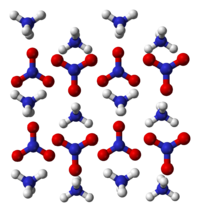
Photo from wikipedia
Abstract Diethyl phthalate (DEP) and N (III) are both ubiquitous pollutants in atmospheric hydrometeors. The cross-reaction pathways and kinetic parameters between DEP and N (III) in the atmospheric aqueous environment… Click to show full abstract
Abstract Diethyl phthalate (DEP) and N (III) are both ubiquitous pollutants in atmospheric hydrometeors. The cross-reaction pathways and kinetic parameters between DEP and N (III) in the atmospheric aqueous environment are explored by using 355 nm laser flash photolysis techniques combined with 365 nm UV light steady-state irradiation. Quantum yields of H2ONO+, HONO and NO2− under 355 nm illuminations are measured as 0.116, 0.231 and 0.036, respectively. Species-specific reaction rate constants of DEP with H2ONO+, HONO and NO2− are determined to be 0.039, 0.07 and 0.008 L mol−1 s−1, respectively. Laser flash photolysis studies indicated HO radicals originating from N (III) photolysis mainly attack aromatic ring of DEP to produce DEP-OH adducts with a second-order rate constant of (4.2 ± 0.1) × 109 L mol−1 s−1. The major transformation products, ethyl salicylate and diethyl 4-hydroxyphthalate (m-OH-DEP) are produced from the attacking of HO on the aromatic ring of DEP, while a small amount of dimethyl phthalate is generated by the hydrogen abstraction on the side chain. DEP-OH is identified as a dominated intermediate which undergoes several decay pathways containing monomolecular decay, interaction with N (III), NO2 and oxygen, the nitration processes of DEP-OH by N (III) and NO2 are crucial to the formation of nitro-compounds. The atmospheric implication of reactions between DEP and HO in bulk water and surface water are also discussed.
Journal Title: Journal of Photochemistry and Photobiology A: Chemistry
Year Published: 2018
Link to full text (if available)
Share on Social Media: Sign Up to like & get
recommendations!